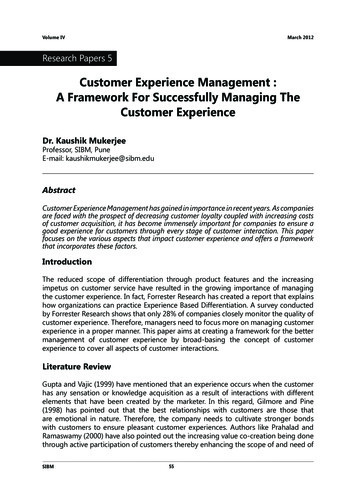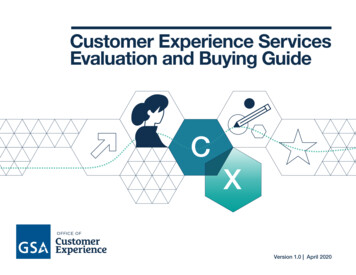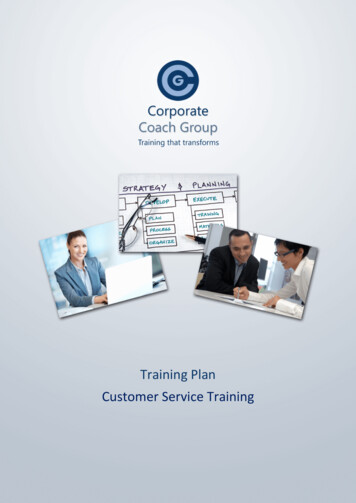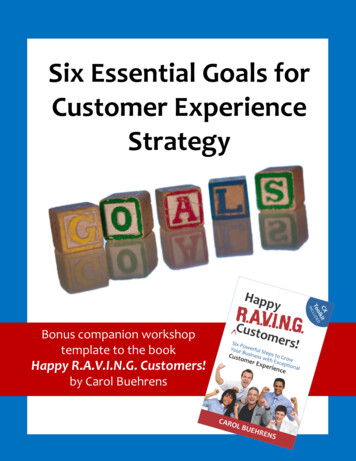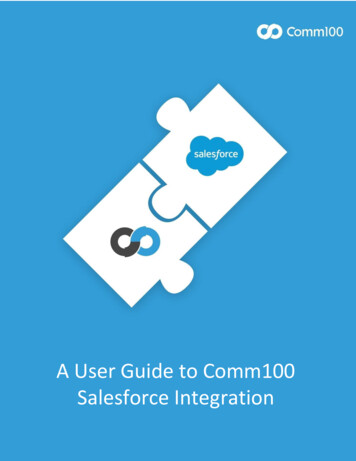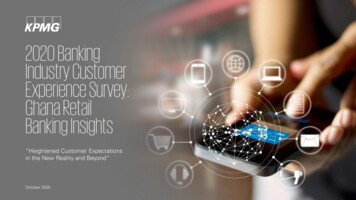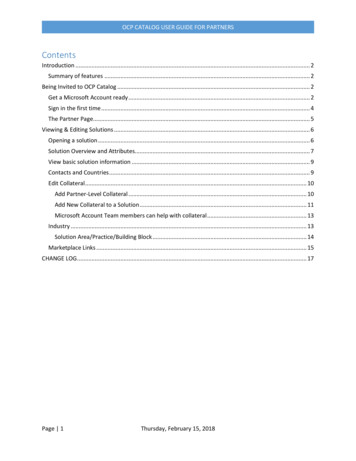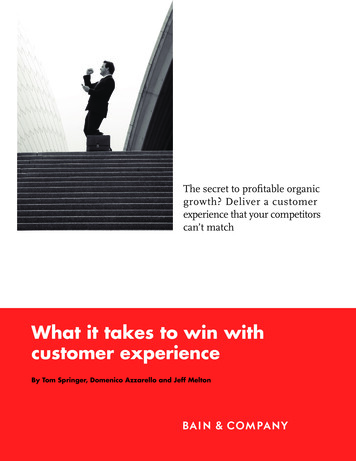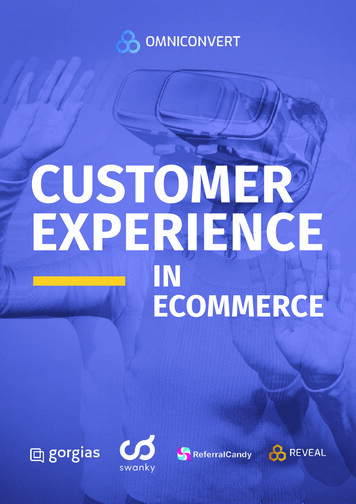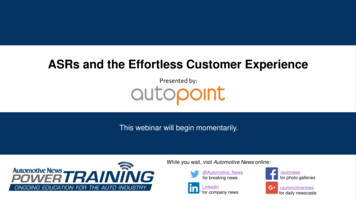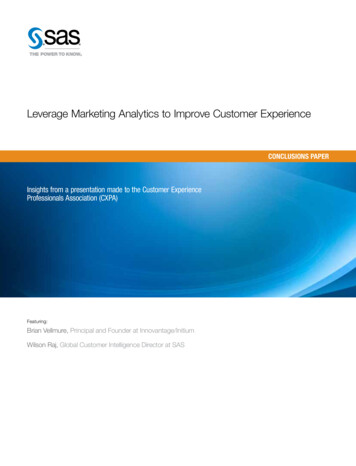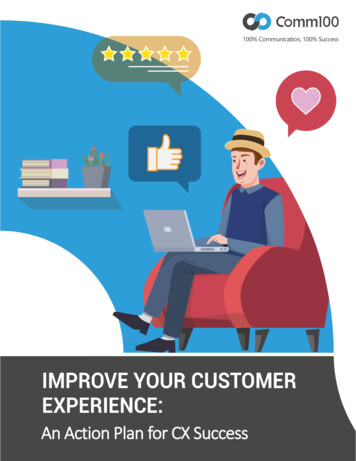
Transcription
An Action Plan for CX Success
ContentsIntroduction . 410 First Steps to Improve Your Customer Experience . 51.Customer-Focused Culture . 52.Know Who Your Customers Are . 63.Mobile Customer Support . 74.Live Chat . 75.Social Media Support . 86.Self-Serve Tools . 87.Suitable Channels for Your Customer Base . 88.Have Someone Responsible for Customer Experience . 99.Be Able to Research and Gather Data . 910.The Ability to Benchmark and Evaluate . 10How to Set Goals & Build a Strategy to Drive Customer ExperienceImprovement . 111.Set Clear Objectives . 112.Understand Customer and Market Perceptions . 123.Developing the CX Strategy . 134.Set Quarterly Milestones that Are in Line with Objectives . 135.Design Customer Service Protocols . 141
6.Implement the CX Strategy . 157.Monitor the System and Make Improvements . 16Customer Experience Mapping: How to Create Smoother, MoreEffortless Journeys . 18What Is a Customer Journey Map? . 18Moving from a Customer Journey Map to Customer Experience Mapping . 20Tools to Create Your Journey . 21Building a Map. 22The Journey Continues . 22Customer Experience Quality & Training: How to Build a WinningFramework within Your Organization . 23Building a Quality Management Framework . 23Creating the Customer Journey . 26Customer Channels and Customer Journeys . 26Fixing Customer Journey Issues . 26Training as a Part of Quality Management . 28How to Use Continuous Improvement Strategies for CustomerExperience Improvement . 30Gathering Insight . 31Identifying Goals. 31Planning the Next Steps . 312
DO! . 32Monitoring the Project . 32Improving the Project. 33Control . 33Important Questions to Ask in Improving Customer Experience . 34Measuring ROI on Customer Experience Projects . 35Customer Experience Map Template . 37About Comm100 . 0Customers . 0Accreditations . 0Contact Us . 03
IntroductionImproving Customer Experience is widely cited as a number 1 priority for companies in 2018, ascompanies wake up to the customer experience as a key strategic priority for continued businesssuccess.While many managers are able to pick out various aspects of the customer experience which could beimproved, turning these thoughts into a successful process which guarantees results is often trickier.With that in mind, we’ve created a complete eBook which lays out all the steps you’ll need to take tobuild a successful customer experience improvement program for your business. This eBook containsbest practice tips from the CX field, encompassing methodologies like Six Sigma to ensure your pathwayto customer experience improvement is clear and straightforward.This eBook contains the following chapters: 10 First Steps to Improve Your Customer Experience How to Set Goals & Build a Strategy to Drive Customer Experience Improvement Customer Experience Mapping: How to Create Smoother, More Effortless Journeys Customer Experience Quality & Training: How to Build a Winning Framework within YourOrganization How to Use Continuous Improvement Strategies for Customer Experience ImprovementThis eBook also includes a template to use for your customer experience mapping sessions, which ties inwith the chapter “Customer Experience Mapping: How to Create Smoother, More Effortless Journeys”.4
10 First Steps to Improve Your Customer ExperienceAccording to CX Network’s 2017 Digital Marketing Trends Report, customer experience ranks first as themost exciting opportunity for businesses for the third year in a row. At 22%, it is ahead of contentmarketing (15%), mobile (13%), personalization (11%) and social marketing (7%).It is no surprise that customer experience ranks highly. Studies have shown that companies that followthrough with customer experience strategies achieve increased revenue, higher customer satisfactionrates and fewer complaints in general.Customer experience is described as the sum total of all the experiences and interactions that thecustomer has had from your business relationship.It is very different from “customer service” which is focused more on the way a service is deliveredbefore, during and after the purchase. The two are however tied very closely together and aresomewhat interdependent.Generally speaking, a customer’s first point of contact with a business is either via the phone, email orone-on-one interactions. This should be the first place to execute your customer experienceimprovement program.In order to develop a successful customer experience strategy, you first have to have a vision,understand and relate to your customers, get real-time feedback while also managing employeeresponses and following a preset framework.Having an organizational framework that is aligned with customer experience is important because allthe employees have to chip in. Knowing your customer allows you to select the best communicationchannels to use for better CX.Here are 10 first steps to improve your customer experience.1. Customer-Focused CultureThe first step is to create a culture that is focused on customer satisfaction. The perspective ofthe customer has to be factored into the company vision and instilled into your company’semployees if you stand a chance of succeeding in your CX efforts.5
The best way to do this is to create a list of statements that will serve as guiding principles, andfocus all staff around these.Zappos, for instance, use their core family values which have been ingrained into their culture todeliver exemplary service, show humility, and welcome change.Starbucks also carries out several customer experience seminars where employees are trainedon etiquette, addressing customer complaints and standard responses to use.Both companies have benefitted from having a customer-oriented culture, both in terms ofrevenue and customer loyalty.These guiding principles will drive the organization’s behavior when they are embedded intoevery employee, ensuring that decisions made are customer-friendly and that no action takesplace without a deep consideration of how it will affect your customers.2. Know Who Your Customers AreSecond, know who your customers are and address their specific needs to improve yourcustomer experience.Not all customers have the same needs and you can find many different types of customerscontacting your contact center – all with different desires and expectations.Knowing customer demographics like age, race, and residence is not enough – think morewidely to consider the ways they’ll be using your products and services, their expectations ofservice from you, and they ways they prefer to interact with you, for example.With a deep understanding of who your customers are, employees should empathize with yourcustomers and view the service from their point of view, enabling you to deliver betterexperiences across the board.One way you can do this is by creating customer personas with a name and personalityattached, and getting your staff to contribute to this. For example, “Fridah is 29 years old andlikes following a video tutorial,” or “James, 44 prefers reading manual instructions on thewebsite.”6
You should find that simply by humanizing your customers through overt profiles andchallenging your staff to think more deeply about their needs, your staff start to think less aboutyour products and services in isolation, and start to think more about how they fit yourcustomer base.3. Mobile Customer SupportMobile phones are the fastest adopted technology of modern times, and in the U.S more than91% of adults own a cell phone. Out of these, 63% use their phones a few times every month tosearch for products and customer support.But many mobile interfaces are badly designed and difficult to use, even when website contentis optimized for mobile viewing. This results in customers calling the company for simple queriesthey could have solved themselves, causing contact centers to become flooded with queries.Companies using customized call tracking and chat software can benefit from built-inintegrations that make support resources available for mobile viewing. This greatly improvescustomer experience since the customer can get their problem solved on their mobile phone.4. Live ChatLive chat is crucial in improving customer experiences as it offers a real-time channel to findsolutions for customers without having them leave your website.Younger demographics especially prefer live chat over phone interactions, with more than 56%of people between 18 and 34 preferring live chat.Live chat is especially popular among online retailers who don’t want to let customers slip awayif they’re the least bit interested. But nowadays, live chat is not restricted to eCommerce, or tosimple text-based messaging. Some providers allow co-browsing, where the customer careagent takes temporary control over the user’s browser and provides technical troubleshootingor directs them to pages where they will find resources. Not to mention the influx ofaudio/video chat services, integrated knowledge bases and Chatbot services.Live chat can also boost business operations by collecting contextual information that tells theagent what pages have been visited before and which products have already been viewed. This7
metadata can be used to improve sales and marketing efforts, as well as improve technicaltroubleshooting for support staff.5. Social Media SupportSocial media is not just for individuals. Many of the biggest brands use it as a way ofcommunicating with the customers in a more customer-centric way.Companies can share interesting content and answer questions from customers on social mediaplatforms. Also, by asking interesting questions, the marketing department can get morecustomer insight which is a crucial step in developing a customer experience strategy.6. Self-Serve ToolsSelf-service portals are doubly useful for companies because they can improve customerexperience and increase the company’s capacity by reducing workload.Customers who have experienced a negative encounter with a call center will prefer the selfservice portal. Younger customers who expect instant gratification, and will lose their marbles iftheir customer care call or live chat goes wrong, are often better off with self-help to stopqueries in their tracks and provide support instantly.With dissatisfaction rates standing at 57%, according to Forrester Research, it is a great CXstrategy to provide self-serve tools. Empowering customers to take matters into their ownhands can improve their customer experience by itself.Bear in mind too that customers are very informed about the product even before they talk tothe salesperson, and a self-serve portal is reassuring to them.7. Suitable Channels for Your Customer BasePart of providing a remarkable customer experience is to communicate to customers oversuitable communication channels. Gone are the days when you only had to call customer care toget assistance.Nowadays, you can interact with customers over text, email, text message and social mediadepending on what they are comfortable with.8
For instance, people above 40 could prefer calling while a younger demographic are going toenjoy the experience of connecting over social media.Consider your industry, too. If you’re working in a very formal professional industry,communication by phone call or even post might be more appropriate for communications thansocial media.No single interaction medium fits all, and you will need to experiment to find out which fits thebill for your customers.8. Have Someone Responsible for Customer ExperienceCustomer experience is often a multi-disciplinary effort, overlooking a myriad of departmentsincluding customer service, marketing, sales, product and so on. A customer experiencemanager or CXM is the link between the customer and the company, and the person who helpscoordinate CX work across these different departments.A CXM’s role is to engineer the product’s life cycle, from the customer’s perspective, frombeginning to end. Having someone to be responsible for customer experience can helpconsolidate efforts from different departments towards one common goal.The CXM is responsible for all customer engagement tasks and comes up with relevant contentfor each target market. This exposes him/her to customer feedback that in turn is used to steerthe product in the right direction.When it comes to redesigning a product or service, the customer experience manager providesinsight in the formulation of such a re-launch. The CXM then follows the product to the end ofits life cycle and maximizes profits before pulling the plug on production and distribution.9. Be Able to Research and Gather DataConducting research and data collection is crucial to the customer experience.When customers call your company, they expect a certain quality of service. To win them over,you need to deliver above average. Customers have a higher likelihood to pay more money ifthe customer service they receive is exemplary. A recent report from ICMI confirmed that 69%of customers will do that.9
Exceptional service doesn’t happen by accident — you have to conduct extensive research andgather feedback from the customer to establish their needs, wants and expectations, and togauge where you can deliver more. Not only is data important in the formulation of a customerexperience strategy, data will also be needed to measure results.This brings us to the next point:10. The Ability to Benchmark and EvaluateAre the processes, team-work, and technology paying off? Without measuring the ROI ofcustomer experience, all the efforts will be futile.To come up with the best strategy means trying out different things and being able to collectdata will ensure you know what works and what doesn’t. One way to measure the effectivenessof a strategy is to ask “Would you recommend this service to a friend or relative?” You can use a5-point or 10-point scale to rate how happy or unhappy they were with the service.Customer experience is the new battleground, and prioritizing it will give you an edge over yourcompetition. But there needs to be a common vision, shared and ingrained in all the employees.This will take some time, but when the right values are instilled into the company culture, it will be ahuge payoff. Remember to benchmark and analyze the methods you use to ensure you are gettingbusiness results. A customer experience campaign can be costly, but you can profit from it by closelymonitoring results.10
How to Set Goals & Build a Strategy to DriveCustomer Experience ImprovementEvery company out there is trying to be more customer-centric, and the race for an excellent customerexperience is heating up. Nowadays, having competitive prices and bombarding customers withadvertisements and offers is not enough. Customers are smarter than before, and most of them alreadyknow your products and services intimately, based on online research or referrals, before making apurchase. These enlightened customers demand a certain quality of interaction and service from yourcompany.Creating a positive customer journey — from the first interaction (calls, live chat, emails or social media)to the purchase and even after the sale is made — is paramount if you want to attract and retaincustomers.Numerous studies have shown that customers are willing to pay more money for good service.Therefore, any company trying to improve their customer experience should follow a defined plan toadopt a strategy that is congruent with their customer expectations.Here is a detailed step-by-step guide to setting goals and strategizing for customer experienceimprovement.1. Set Clear ObjectivesThe first step to improve customer experience should be to ask yourself what exactly you planon accomplishing.Nine out of ten managers confirm that customer experience is a strategic objective forincreasing sales and revenue. However, most managers do not ask what the end goal is beforeengaging in a CX improvement project.A clear understanding of your business objectives is required. After identifying these objectives,you should identify who will be affected, and effectively prioritize and segment these people.For example — identify which customers will be affected, what importance do each customergroup have, and set out why they need a CX improvement. Other people affected include theemployees on the frontline, for example, call center agents and sales representatives.Here are some examples of objectives:11
a. Business ObjectivesSome of the business objectives you can use include customer retention, customersatisfaction, product purchases, purchase volume, purchase frequency, products returned,the number of dissatisfied customers and revenue.These objectives allow you to evaluate the effectiveness of your customer experiencestrategy to convert into business results. They should be quantifiable and measurable.b. Customer Experience ObjectivesExamples of CX objectives include; giving customers more control, creating partnerships thatimprove customer experience (e.g. collaborating with a payment or shipping company),identifying target markets, increasing responsiveness and so forth.Certain pitfalls must be avoided in this step, such as accounting for insufficient customerdata, lack of business data and avoiding the assumption that all customers in your targetgroup have the same views.2. Understand Customer and Market PerceptionsCustomer experience improvement is centered on the perceptions of the customer, not thebusiness.In order to improve CX, you should understand the customer’s idea of an ideal interaction. Thisincludes the needs at every stage of the CX life cycle, interactions with your business and thedifficulties they encounter. The CX program should be from the customer’s perspective, whichcan be achieved by: Collecting customer experiences and views Identifying gaps in the customer experience Conducting internal workshops Mapping the customer journey Conducting customer, market, and employee research12
Failing to include customers and stakeholders at all levels will be detrimental to your customerexperience improvement efforts. It should be noted that the right customers should be involved,for example, the customers in your target group according to age, gender, location and so forth.3. Developing the CX StrategyNow that you know your objectives and have carried out the research, it’s time to develop astrategy that will guide your customer experience.This phase involves planning a strategy that consistently meets customer expectations or “idealexperiences.” When developing your strategy, you will understand what resources are required,the time it will take and the specific activities you need to carry out changes.Prioritize activities and allocate them to employees. It is also imperative that you start instilling acustomer-focused attitude among employees through workshops and training, as well asensuring your own stated values and behavior role-model what you want to achieve.Here are some activities to consider: Define the strategy Create business cases and situations Identify gaps in the current CX strategy Get buy-in from executives by involving them in the projectThe strategy should be tied to your brand and customers should associate your brand with theexperience.Involving executive management and staff is crucial. From your objectives, you should outlinethe expectations of your project, which employees can use to monitor progress and achieve thedesired customer experience.4. Set Quarterly Milestones that Are in Line with ObjectivesThis is an extension of the strategy development phase. Setting goals to be achieved quarterlywill motivate employees and keep them focused. These goals will also be a yardstick to measurethe success of your strategy. The achievement of these goals has to be tied to the overall13
objectives outlined in step one. Using our business objectives, you can develop some questionssuch as: What can we do to reduce the number of returned products to 5% this quarter? Which strategy can we use to increase how frequently existing customers buy ourproducts? How can we reduce delays to customer calls and increase responsiveness this quarter? What actions will improve our customer satisfaction ratings? What initiative can help increase customer retention by 1% this quarter?These questions can be used to measure up against the quarterly goals.Progress should be reviewed constantly and in a systematic manner. Team meetings, forinstance, should be used to monitor progress and individuals should be assigned activities thatwill help in achieving the goals. Also, outline progress indicators which can be reviewed inperiodic meetings.5. Design Customer Service ProtocolsGuided by the ideal customer interaction and the CX strategy, develop a protocol for customerservice that will consistently offer value over the long term.Remember that these protocols will differ with customer groups because of their differentneeds. Developing this framework will help you create positive touchpoint experiences thatcustomers can come to expect from your brand. The activities to be carried out in this stepinclude: Designing specific customer experiences that meet customer expectations Defining metrics and key performance indicators Create a framework to outline priorities Map out an implementation map and journey map14
Redesign current processes and servicesOne way to do this is to involve employees (especially those who interact with customers) inrole-playing activities, or by creating a persona of a customer.For example, Juliet is 26 years old, does her shopping online through her phone and uses the livechat feature for customer support, while 44-year-old John collects coupons from his mailing listto shop at your store, and prefers physically visiting your customer care desk.This will help create a model for interacting with the two completely different customers andhelp you to deliver their ideal experiences.Apart from this, your protocols should outline the activities that happen behind the scenes tocreate the customer experience. Interdependencies will be uncovered and the interaction withpeople, technology, and touch points will be smoothed out as a result.6. Implement the CX StrategyNext, using the material from the previous step, implement the customer experience strategy,starting internally.This means training employees, redesigning systems, establishing internal communicationchannels and aligning rewards with the achievement of set goals.Implementation is often time-consuming and resource-heavy because all staff must be involved.Executive management needs to support the initiative and lower tier employees need to beshown the importance of the initiative.Additionally, employee rewards must be tied to goal achievement so that they can support theCX strategy. Customer experience will be driven by the customer-centric organizational culture –it’s a win-win situation once you have your program off the ground.This exercise can also help to bridge operational gaps that hinder customer service, likedepartmental communication barriers.Activities included in this step are: Planning and executing internal communications15
Training Improving touch points and customer interactions Empowering employees to offer insight and ideas to improve the strategy Testing the strategy on preselected customers7. Monitor the System and Make ImprovementsAfter delivering the system to the customer, the company should monitor how effective it is inimproving the customer experience. It will take some time to measure effectiveness, and youshould compare the results with internal goals and metrics.Customer feedback is very important and you should listen to customers to know where thesystem is failing. This can be done by measuring customer perceptions after they are introducedto the new system.Other metrics to measure progress with are external metrics, monitoring your competition’scustomers, and listening to employee feedback.You should also compare the customer experience between different customer groups andmake specific improvements to the affected areas. The following activities can help in makingimprovements: Gather customer experiences from the new system Evaluate its impact on business objectives Track and monitor performance using KPIs Collect and act upon customer insightsContinuous improvement is required after this stage too, since market forces are dynamic andthe customer’s idea of an “ideal experience” can change over time. Therefore, it is important tocontinually monitor the customer experience and act on data collected.16
Most managers, when tasked with customer experience improvement, look to create a new strategythat will radically change the way they do business. However, a more incremental approach as we’vedescribed ensures constant improvements, at a manageable scale.Building upon the existing customer experience is the best strategy for success here, and by followingthese steps, you can ensure that you can plan, implement and track improvements to your service,helping you to demonstrate real business benefit.17
Customer Experience Mapping: How to CreateSmoother, More Effortless JourneysLet's be honest, companies do not send out newsletters promoting massive “wins” and provide hugecommission checks when an internal team manages to “save” a customer. Their focus is usually ongrowing the business, and that really only happens when you gain new accounts.8 out of 10 marketers of global companies actually agree that a much better strategy is retention, buttheir organizations are still focused on customer acquisition. However, costs to acquire new accountsare not inconsequential — nor is there any guarantee that the investment will actually lead to
How to Use Continuous Improvement Strategies for Customer Experience Improvement This eBook also includes a template to use for your customer experience mapping sessions, which ties in with the chapter Customer Experience Mapping: How to Cr
